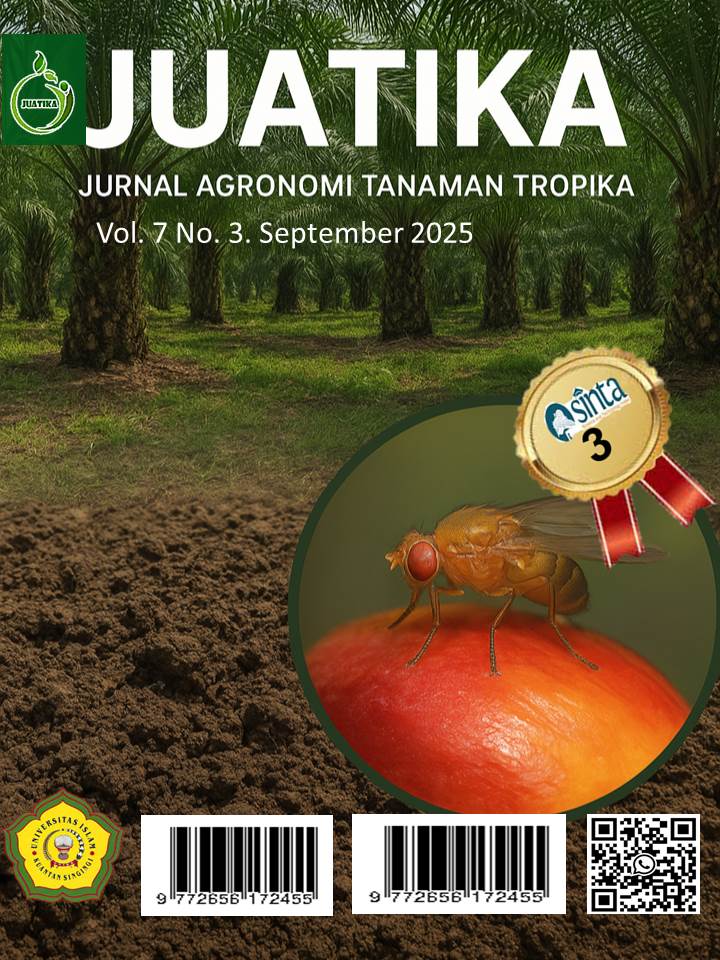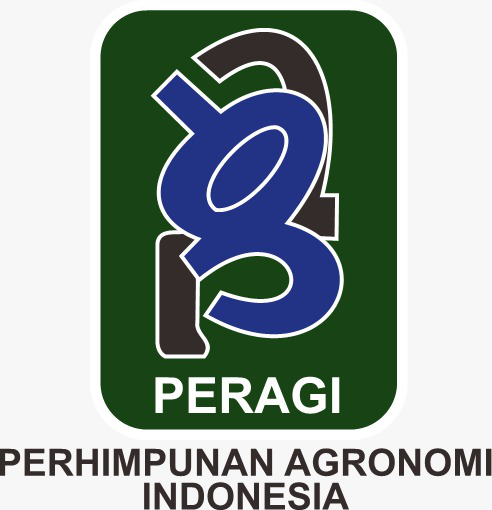Increasing Growth and Yield of Soybeans (Glycine max L.) by Providing Banana Stem LOF and SP-36 Fertilizer
Abstract
Soybean productivity in Indonesia remains relatively low, partly due to declining soil fertility. One approach to address this issue is the application of liquid organic fertilizer (LOF) and phosphate fertilizers, such as SP-36. This study aimed to evaluate the effects of various concentrations of banana corm-based LOF and different doses of SP-36 fertilizer, as well as their interaction, on the growth and yield of soybean plants (Glycine max L.). The research was conducted in Medokan, Surabaya, using a two-factorial Randomized Block Design (RBD) with four levels of LOF concentration (0, 500, 600, and 700 ml/l) and three levels of SP-36 concentration (150, 200, and 250 kg/ha). The observed parameters included plant height, number of pods, percentage of empty pods, seed weight per plant, seed weight per hectare, and fruit set. The results indicated a significant interaction between LOF and SP-36 on plant height 42 days after planting, number of pods, percentage of empty pods, and fruit set. The most effective treatment was the combination of 600 ml/l banana corm LOF and 200 kg/ha SP-36. However, seed weight per plant and hectare did not show a significant effect. This study concludes that the appropriate combination of banana corm LOF and SP-36 fertilizer can significantly enhance soybean growth and yield. It is recommended to use 600 ml/L of banana corm LOF combined with 200 kg/ha of SP-36 fertilizer to optimize plant height, number of pods, and fruit set in soybean cultivation.
Downloads
References
Amir, N., & Fauzy, M. F. (2018). Pengaruh jenis pupuk organik cair limbah tanaman dan takaran pupuk kotoran ayam terhadap pertumbuhan tanaman kedelai (Glycine max L. Merrill). Klorofil: Jurnal Penelitian Ilmu-Ilmu Pertanian, 13(1), 17–21. https://doi.org/10.32502/jk.v13i1.1094
Ardian, A., Yoseva, S., Naibaho, P. S., & Pramana, A. (2023). Increased growth and yield of peanuts (Arachis hypogaea L.) with tillage and liquid organic fertilizer fish waste. Jurnal Agronomi Tanaman Tropika (JUATIKA), 5(2). https://doi.org/10.36378/juatika.v5i2.3075
Ariani, E., Lubis, N., Gusmawartati, Yoseva, S., Irfandri, & Hanum, M. (2025). The effect of rabbit urine LOF and NPK fertilizer on green bean plants (Vigna radiata L.). Jurnal Agronomi Tanaman Tropika (JUATIKA), 7(1). https://doi.org/10.36378/juatika.v7i1.3901
Chaniago, N., Purba, D. W., & Utama, A. (2017). Respon pemberian pupuk organik cair (LOF) bonggol pisang dan sistem jarak tanam terhadap pertumbuhan dan produksi kacang hijau (Vigna radiata L. Willczek). Jurnal Penelitian Pertanian Bernas, 13(1).
Febriani, D. A., Darmawati, A., & Fuskhah, E. (2021). Pengaruh dosis kompos ampas teh dan pupuk kandang ayam terhadap pertumbuhan dan produksi mentimun (Cucumis sativus L.). Jurnal Buana Sains, 21(1), 1–10. https://doi.org/10.33366/bs.v21i1.2657
Gusmiatun, Palmasari, B., & Firnandi, D. O. (2023). Peningkatan produksi kedelai (Glycine max (L.) Merrill) melalui pemberian pupuk limbah cucian ikan dan pupuk P. Klorofil: Jurnal Penelitian Ilmu-Ilmu Pertanian, 18, 25–29. https://doi.org/10.32502/jk.v18i1.6459
Habi, M. L., Nendissa, J. I., Marasabessy, D., & Kalay, A. M. (2018). Ketersediaan fosfat, serapan fosfat, dan hasil tanaman jagung (Zea mays L.) akibat pemberian kompos granul ela sagu dengan pupuk fosfat pada Inceptisols. Agrologia, 7(1). https://doi.org/10.30598/a.v7i1.356
Hodijah, S., Rusmiyanto, E. P., & Mukarlina. (2023). Pertumbuhan kedelai (Glycine max (L.) Merrill) varietas Anjasmoro dengan pemberian pupuk organik cair bonggol pisang kepok (Musa acuminata L.). Ziraa’ah: Majalah Ilmiah Pertanian, 48(3), 449–456.
Kurniawan, I., Afa, L., & Yusuf, D. N. (2022). Respon pertumbuhan kacang tanah (Arachis hypogaea L.) pada berbagai dosis bokashi limbah ampas tahu dan pupuk fosfat. Jurnal Agroteknos, 12(1), 28–37.
Puspitasari, A., & Elfarisna. (2017). Respon pertumbuhan dan produksi kedelai varietas Grobogan dengan penambahan pupuk organik cair dan pengurangan dosis pupuk anorganik. Prosiding Semnastan, 8, 204–212.
Saputra, R. (2021). Respon produksi tanaman gambas (Luffa acutangula L. Roxb) terhadap LOF buah-buahan dan pupuk P [Skripsi, Universitas Islam Riau].
Sari, D., & Rahmawati, A. (2020). Pengelolaan limbah cair tempe air rebusan dan air rendaman kedelai. Jurnal Ilmiah Kesehatan Media Husada, 9(1), 47–54. https://doi.org/10.33475/jikmh.v9i1.210
Sipayung, P., Hutauruk, S., Purba, A. H., & Sidauruk, L. (2023). Respon pertumbuhan dan produksi kedelai hitam Malika (Glycine soja L.) terhadap media tanam cocopeat-topsoil dan pupuk fosfor. Jurnal Agriland, 9(1), 115–123. https://doi.org/10.46880/mtg.v9i1.2149
Utami, C. D., Herlinawati, & Rosdiana. (2021). Aplikasi pupuk hayati mikoriza dan beberapa jenis pupuk hijau terhadap hasil tanaman kedelai (Glycine max L.). Bernas: Jurnal Penelitian Pertanian, 13(2), 1–8.
Wicaksono, W. A. (2015). Respon pertumbuhan dan produksi tanaman kedelai (Glycine max (L.) Merrill) terhadap pemberian pupuk P dan pupuk organik cair azolla [Skripsi, Universitas Muhammadiyah Jember].
Copyright (c) 2025 Dela Tri Astuti Lumban Gaol, Yonny Koentjoro, Nova Triani

This work is licensed under a Creative Commons Attribution 4.0 International License.
Authors who publish with Jurnal Agronomi Tanaman Tropika (JUATIKA) agree to the following terms:
Authors retain copyright and grant the Jurnal Agronomi Tanaman Tropika (JUATIKA) right of first publication with the work simultaneously licensed under a Creative Commons Attribution License (CC BY 4.0) that allows others to share (copy and redistribute the material in any medium or format) and adapt (remix, transform, and build upon the material for any purpose, even commercially) with an acknowledgment of the work's authorship and initial publication in Jurnal Agronomi Tanaman Tropika (JUATIKA).
Authors are able to enter into separate, additional contractual arrangements for the non-exclusive distribution of the journal's published version of the work (e.g., post it to an institutional repository or publish it in a book), with an acknowledgment of its initial publication in Jurnal Agronomi Tanaman Tropika (JUATIKA). Authors are permitted and encouraged to post their work online (e.g., in institutional repositories or on their website) prior to and during the submission process, as it can lead to productive exchanges, as well as earlier and greater citation of published work.







 More Information
More Information


